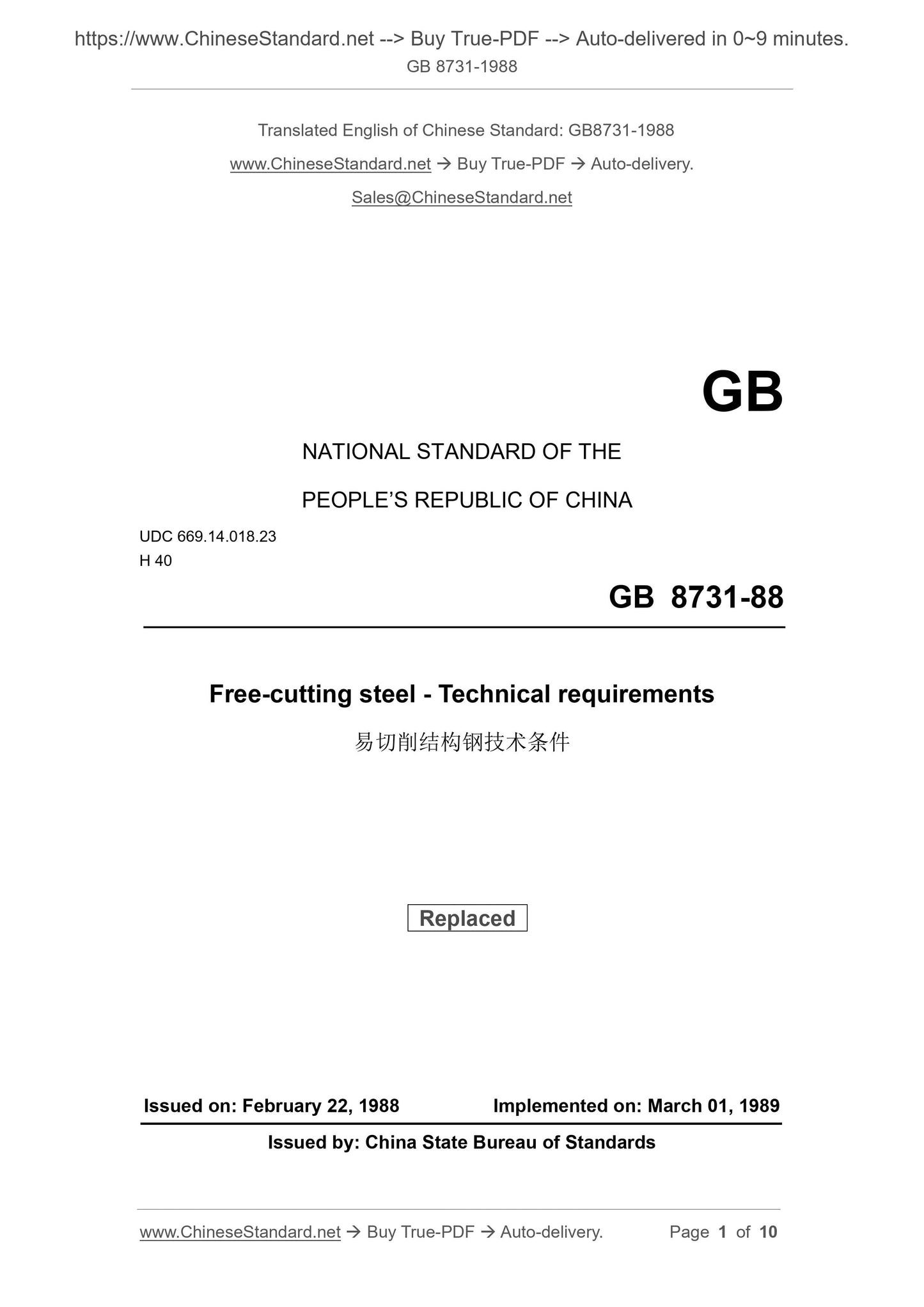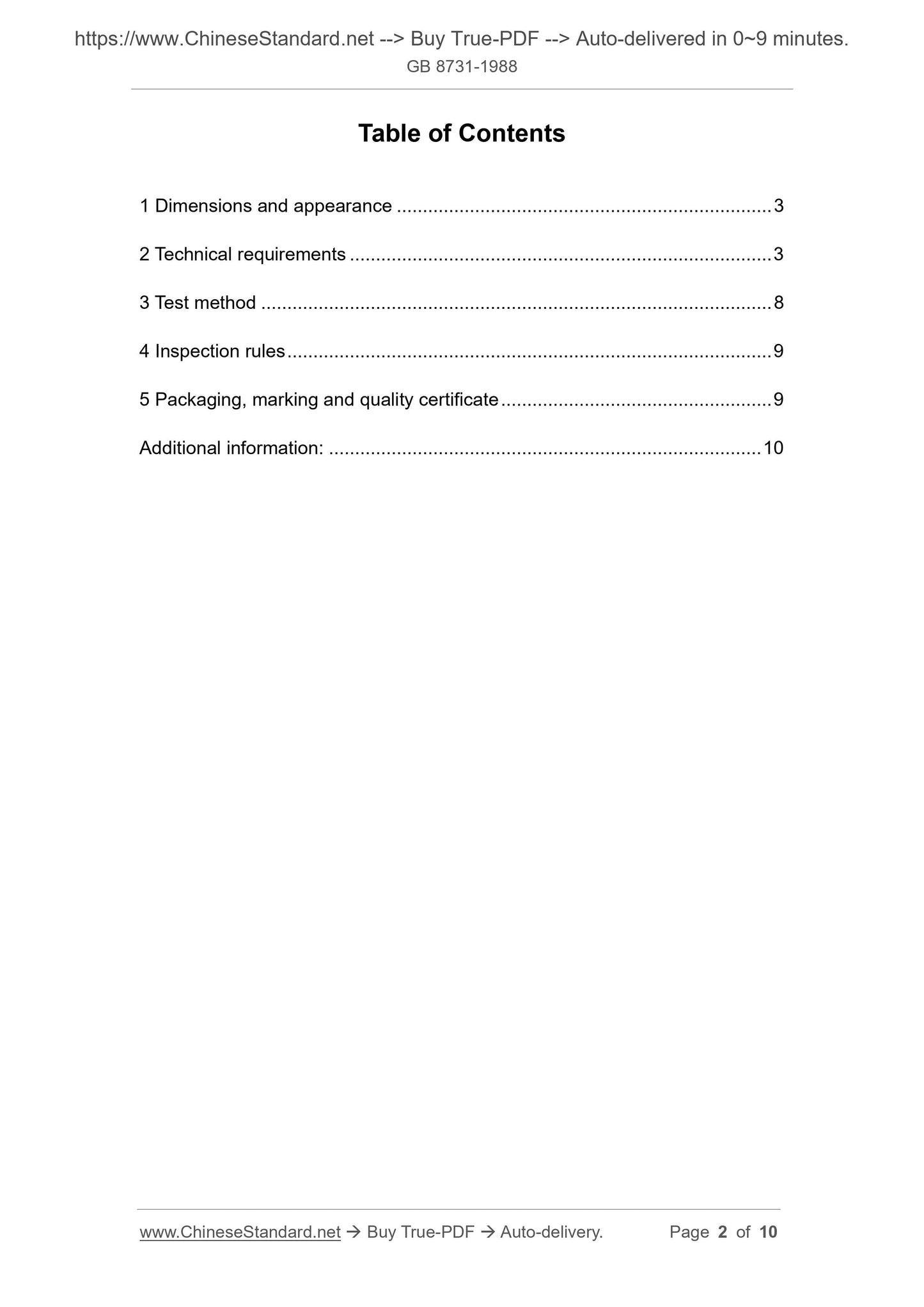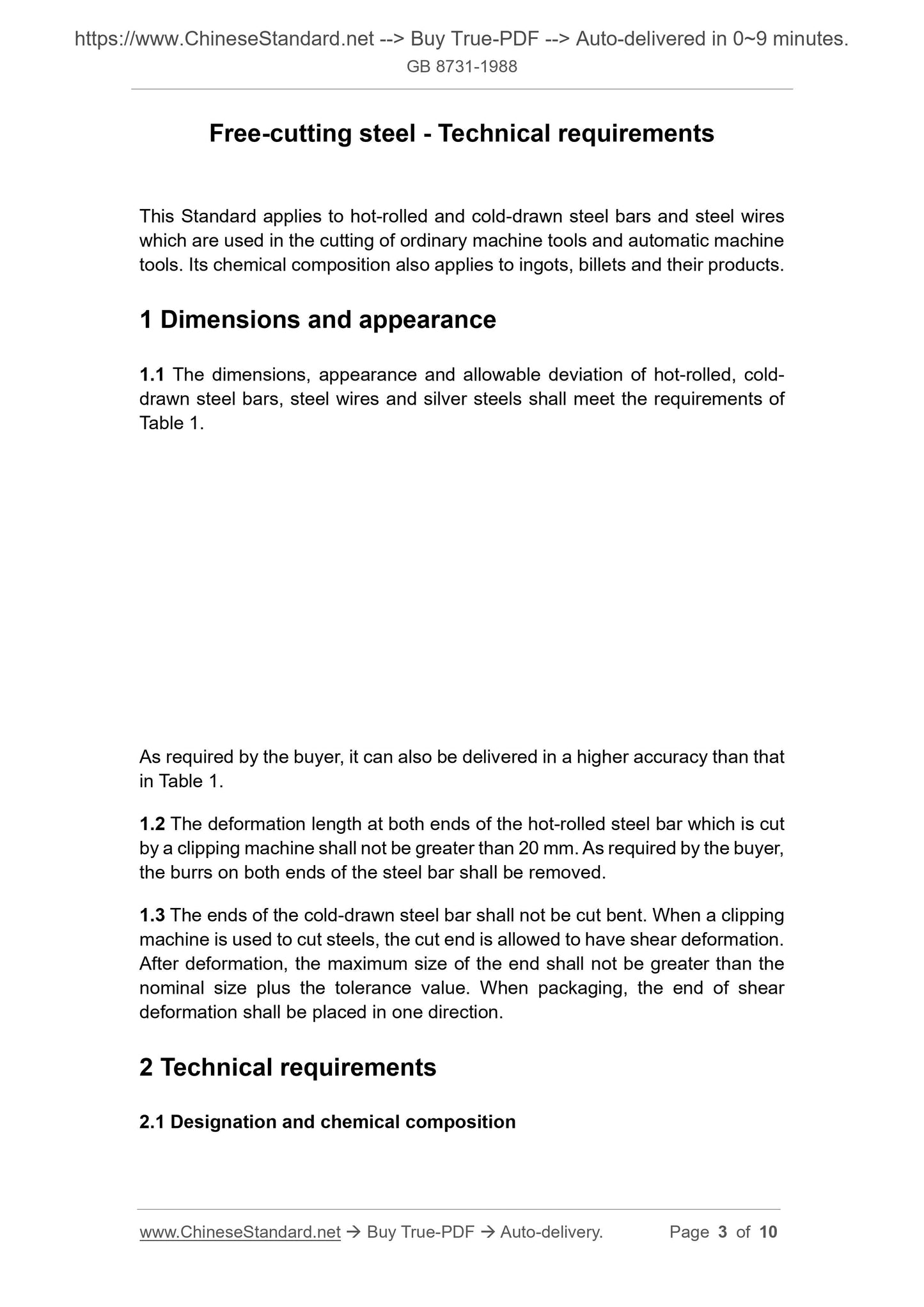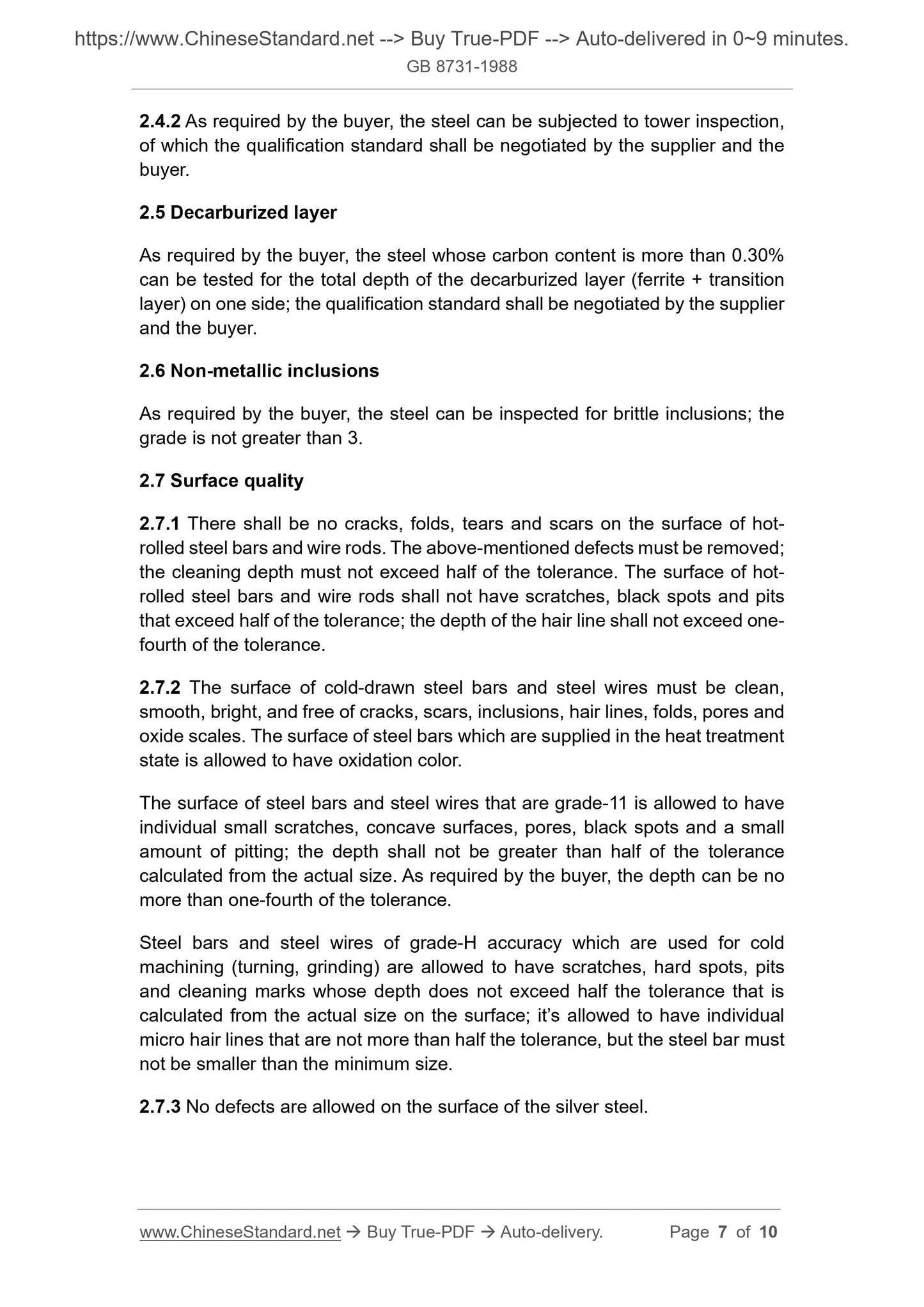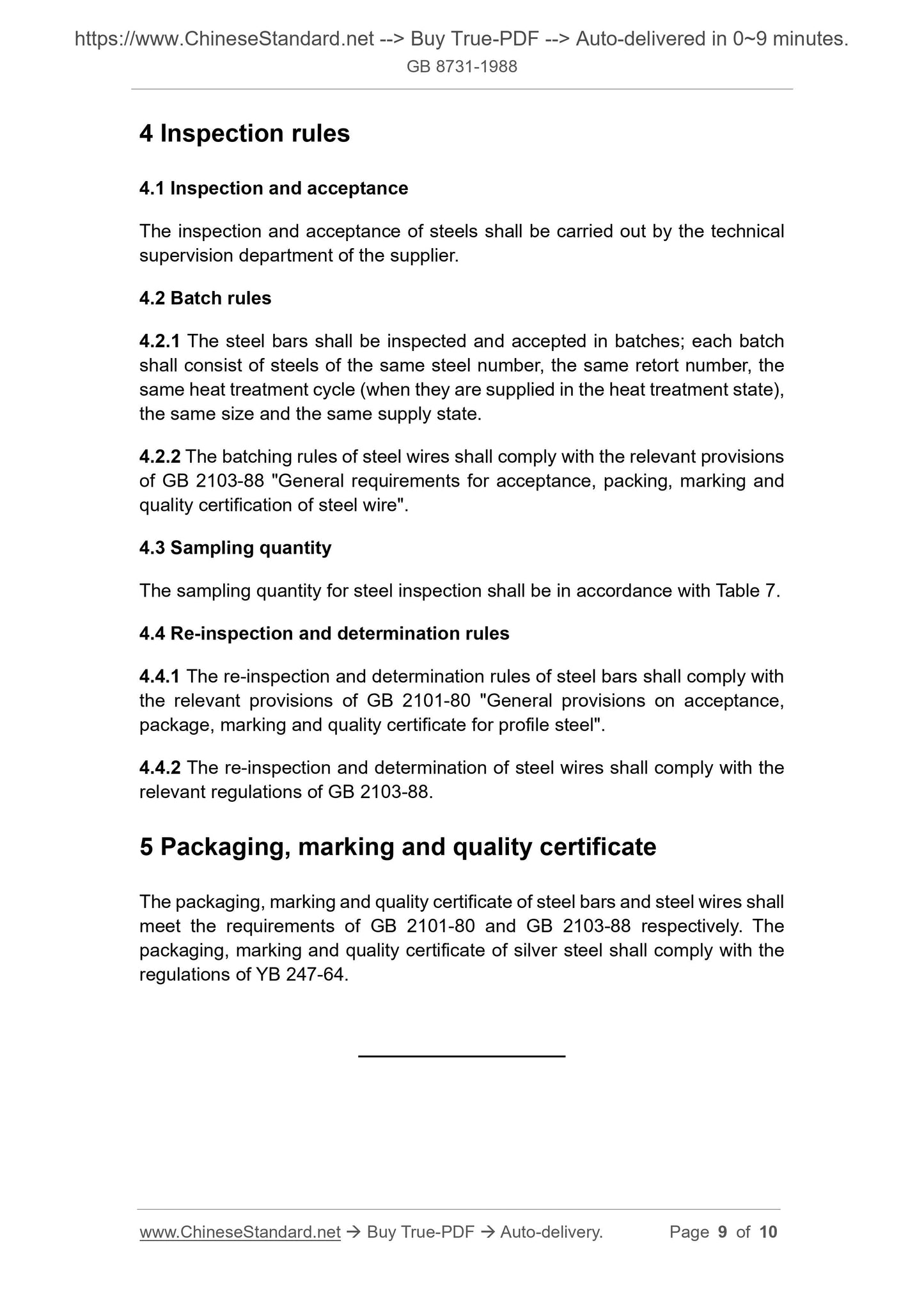1
/
of
5
PayPal, credit cards. Download editable-PDF and invoice in 1 second!
GB/T 8731-1988 English PDF (GBT8731-1988)
GB/T 8731-1988 English PDF (GBT8731-1988)
Regular price
$285.00 USD
Regular price
Sale price
$285.00 USD
Unit price
/
per
Shipping calculated at checkout.
Couldn't load pickup availability
Delivery: 3 seconds. Download true-PDF + Invoice.Newer version: (Replacing this standard) GB/T 8731-2008
Get QUOTATION in 1-minute: Click GB/T 8731-1988
Historical versions: GB/T 8731-1988
Preview True-PDF (Reload/Scroll if blank)
GB/T 8731-1988: Free-cutting steel--Technical requirements
GB 8731-1988
GB
NATIONAL STANDARD OF THE
PEOPLE’S REPUBLIC OF CHINA
UDC 669.14.018.23
H 40
GB 8731-88
Free-cutting steel - Technical requirements
Replaced
ISSUED ON: FEBRUARY 22, 1988
IMPLEMENTED ON: MARCH 01, 1989
Issued by: China State Bureau of Standards
Table of Contents
1 Dimensions and appearance ... 3
2 Technical requirements ... 3
3 Test method ... 8
4 Inspection rules ... 9
5 Packaging, marking and quality certificate ... 9
Additional information: ... 10
Free-cutting steel - Technical requirements
This Standard applies to hot-rolled and cold-drawn steel bars and steel wires
which are used in the cutting of ordinary machine tools and automatic machine
tools. Its chemical composition also applies to ingots, billets and their products.
1 Dimensions and appearance
1.1 The dimensions, appearance and allowable deviation of hot-rolled, cold-
drawn steel bars, steel wires and silver steels shall meet the requirements of
Table 1.
As required by the buyer, it can also be delivered in a higher accuracy than that
in Table 1.
1.2 The deformation length at both ends of the hot-rolled steel bar which is cut
by a clipping machine shall not be greater than 20 mm. As required by the buyer,
the burrs on both ends of the steel bar shall be removed.
1.3 The ends of the cold-drawn steel bar shall not be cut bent. When a clipping
machine is used to cut steels, the cut end is allowed to have shear deformation.
After deformation, the maximum size of the end shall not be greater than the
nominal size plus the tolerance value. When packaging, the end of shear
deformation shall be placed in one direction.
2 Technical requirements
2.1 Designation and chemical composition
2.4.2 As required by the buyer, the steel can be subjected to tower inspection,
of which the qualification standard shall be negotiated by the supplier and the
buyer.
2.5 Decarburized layer
As required by the buyer, the steel whose carbon content is more than 0.30%
can be tested for the total depth of the decarburized layer (ferrite + transition
layer) on one side; the qualification standard shall be negotiated by the supplier
and the buyer.
2.6 Non-metallic inclusions
As required by the buyer, the steel can be inspected for brittle inclusions; the
grade is not greater than 3.
2.7 Surface quality
2.7.1 There shall be no cracks, folds, tears and scars on the surface of hot-
rolled steel bars and wire rods. The above-mentioned defects must be removed;
the cleaning depth must not exceed half of the tolerance. The surface of hot-
rolled steel bars and wire rods shall not have scratches, black spots and pits
that exceed half of the tolerance; the depth of the hair line shall not exceed one-
fourth of the tolerance.
2.7.2 The surface of cold-drawn steel bars and steel wires must be clean,
smooth, bright, and free of cracks, scars, inclusions, hair lines, folds, pores and
oxide scales. The surface of steel bars which are supplied in the heat treatment
state is allowed to have oxidation color.
The surface of steel bars and steel wires that are grade-11 is allowed to have
individual small scratches, concave surfaces, pores, black spots and a small
amount of pitting; the depth shall not be greater than half of the tolerance
calculated from the actual size. As required by the buyer, the depth can be no
more than one-fourth of the tolerance.
Steel bars and steel wires of grade-H accuracy which are used for cold
machining (turning, grinding) are allowed to have scratches, hard spots, pits
and cleaning marks whose depth does not exceed half the tolerance that is
calculated from the actual size on the surface; it’s allowed to have individual
micro hair lines that are not more than half the tolerance, but the steel bar must
not be smaller than the minimum size.
2.7.3 No defects are allowed on the surface of the silver steel.
4 Inspection rules
4.1 Inspection and acceptance
The inspection and acceptance of steels shall be carried out by the technical
supervision department of the supplier.
4.2 Batch rules
4.2.1 The steel bars shall be inspected and accepted in batches; each batch
shall consist of steels of the same steel number, the same retort number, the
same heat treatment cycle (when they are supplied in the heat treatment state),
the same size and the same supply state.
4.2.2 The batching rules of steel wires shall comply with the relevant provisions
of GB 2103-88 "General requirements for acceptance, packing, marking and
quality certification of steel wire".
4.3 Sampling quantity
The sampling quantity for steel inspection shall be in accordance with Table 7.
4.4 Re-inspection and determination rules
4.4.1 The re-inspection and determination rules of steel bars shall comply with
the relevant provisions of GB 2101-80 "General provisions on acceptance,
package, marking and quality certificate for profile steel".
4.4.2 The re-inspection and determination of steel wires shall comply with the
relevant regulations of GB 2103-88.
5 Packaging, marking and quality certificate
The packaging, marking and quality certificate of steel bars and steel wires shall
meet the requirements of GB 2101-80 and GB 2103-88 respectively. The
packaging, marking and quality certificate of silver steel shall comply with the
regulations of YB 247-64.
____________________
Get QUOTATION in 1-minute: Click GB/T 8731-1988
Historical versions: GB/T 8731-1988
Preview True-PDF (Reload/Scroll if blank)
GB/T 8731-1988: Free-cutting steel--Technical requirements
GB 8731-1988
GB
NATIONAL STANDARD OF THE
PEOPLE’S REPUBLIC OF CHINA
UDC 669.14.018.23
H 40
GB 8731-88
Free-cutting steel - Technical requirements
Replaced
ISSUED ON: FEBRUARY 22, 1988
IMPLEMENTED ON: MARCH 01, 1989
Issued by: China State Bureau of Standards
Table of Contents
1 Dimensions and appearance ... 3
2 Technical requirements ... 3
3 Test method ... 8
4 Inspection rules ... 9
5 Packaging, marking and quality certificate ... 9
Additional information: ... 10
Free-cutting steel - Technical requirements
This Standard applies to hot-rolled and cold-drawn steel bars and steel wires
which are used in the cutting of ordinary machine tools and automatic machine
tools. Its chemical composition also applies to ingots, billets and their products.
1 Dimensions and appearance
1.1 The dimensions, appearance and allowable deviation of hot-rolled, cold-
drawn steel bars, steel wires and silver steels shall meet the requirements of
Table 1.
As required by the buyer, it can also be delivered in a higher accuracy than that
in Table 1.
1.2 The deformation length at both ends of the hot-rolled steel bar which is cut
by a clipping machine shall not be greater than 20 mm. As required by the buyer,
the burrs on both ends of the steel bar shall be removed.
1.3 The ends of the cold-drawn steel bar shall not be cut bent. When a clipping
machine is used to cut steels, the cut end is allowed to have shear deformation.
After deformation, the maximum size of the end shall not be greater than the
nominal size plus the tolerance value. When packaging, the end of shear
deformation shall be placed in one direction.
2 Technical requirements
2.1 Designation and chemical composition
2.4.2 As required by the buyer, the steel can be subjected to tower inspection,
of which the qualification standard shall be negotiated by the supplier and the
buyer.
2.5 Decarburized layer
As required by the buyer, the steel whose carbon content is more than 0.30%
can be tested for the total depth of the decarburized layer (ferrite + transition
layer) on one side; the qualification standard shall be negotiated by the supplier
and the buyer.
2.6 Non-metallic inclusions
As required by the buyer, the steel can be inspected for brittle inclusions; the
grade is not greater than 3.
2.7 Surface quality
2.7.1 There shall be no cracks, folds, tears and scars on the surface of hot-
rolled steel bars and wire rods. The above-mentioned defects must be removed;
the cleaning depth must not exceed half of the tolerance. The surface of hot-
rolled steel bars and wire rods shall not have scratches, black spots and pits
that exceed half of the tolerance; the depth of the hair line shall not exceed one-
fourth of the tolerance.
2.7.2 The surface of cold-drawn steel bars and steel wires must be clean,
smooth, bright, and free of cracks, scars, inclusions, hair lines, folds, pores and
oxide scales. The surface of steel bars which are supplied in the heat treatment
state is allowed to have oxidation color.
The surface of steel bars and steel wires that are grade-11 is allowed to have
individual small scratches, concave surfaces, pores, black spots and a small
amount of pitting; the depth shall not be greater than half of the tolerance
calculated from the actual size. As required by the buyer, the depth can be no
more than one-fourth of the tolerance.
Steel bars and steel wires of grade-H accuracy which are used for cold
machining (turning, grinding) are allowed to have scratches, hard spots, pits
and cleaning marks whose depth does not exceed half the tolerance that is
calculated from the actual size on the surface; it’s allowed to have individual
micro hair lines that are not more than half the tolerance, but the steel bar must
not be smaller than the minimum size.
2.7.3 No defects are allowed on the surface of the silver steel.
4 Inspection rules
4.1 Inspection and acceptance
The inspection and acceptance of steels shall be carried out by the technical
supervision department of the supplier.
4.2 Batch rules
4.2.1 The steel bars shall be inspected and accepted in batches; each batch
shall consist of steels of the same steel number, the same retort number, the
same heat treatment cycle (when they are supplied in the heat treatment state),
the same size and the same supply state.
4.2.2 The batching rules of steel wires shall comply with the relevant provisions
of GB 2103-88 "General requirements for acceptance, packing, marking and
quality certification of steel wire".
4.3 Sampling quantity
The sampling quantity for steel inspection shall be in accordance with Table 7.
4.4 Re-inspection and determination rules
4.4.1 The re-inspection and determination rules of steel bars shall comply with
the relevant provisions of GB 2101-80 "General provisions on acceptance,
package, marking and quality certificate for profile steel".
4.4.2 The re-inspection and determination of steel wires shall comply with the
relevant regulations of GB 2103-88.
5 Packaging, marking and quality certificate
The packaging, marking and quality certificate of steel bars and steel wires shall
meet the requirements of GB 2101-80 and GB 2103-88 respectively. The
packaging, marking and quality certificate of silver steel shall comply with the
regulations of YB 247-64.
____________________
Share
